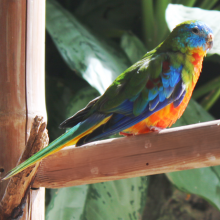
The Turquoisine Parakeet is a small species of parrot that feeds on grass seeds in Eastern Australia. Besides grass seeds, these birds will occasionally eat other available foods like flowers and bugs.
They travel in pairs or flocks of up to 50 individuals, making a variety of sounds to stay in communication with other parrots in their flock. Each parrot keeps an eye out for danger, and a warning call will send the whole flock flying to safety. Their predators include birds of prey like hawks and owls, as well as snakes and mammals like possums.
These parrots nest in tree cavities. They line their nest hollow with soft materials like leaves, bark, and feathers. They typically lay two to five eggs at a time, which are incubated for around 20 days until hatching. The young are fed by both parents and are ready to leave the nest about 23 days later.
This is one of the few parrot species in which it is visually possible to identify males and females. Males have overall brighter colours and a red patch on their wing. Females are less colourful and do not have a red wing patch.
The Turquoisine Parakeet was so rare that it was presumed extinct in 1915. The reason for its population collapse is unknown. Since then its population numbers have risen. It is now considered Least Concern on the IUCN Red List.
